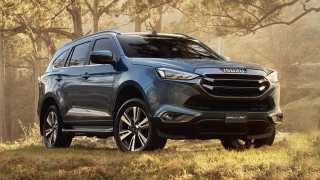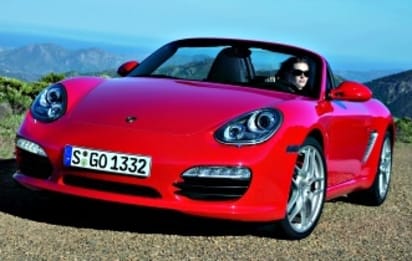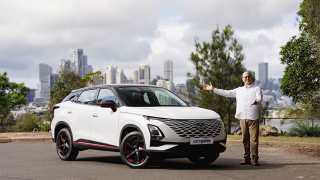
Porsche Boxster 2009 review
- Porsche Boxster
- Porsche Boxster 2009
- Porsche Boxster Reviews
- Porsche Reviews
- Porsche Convertible Range
- Convertible
- Porsche
- Prestige & Luxury Cars
- Sports cars
It winds its way across the face of the hills and in its extension becomes more littered with mud, increasingly calling for aid from the tyres and drivetrain.
Conditions become so bad that earth starts scraping on the underside and pools of water threaten to enter the cabin. On top of that, we are lost.
This picture could have been a lot brighter if (a) we knew where we were and (b) the Porsche was an all-wheel drive Cayenne.
But we are in Sicily and we are lost — except for the cold comfort of scribbly lines on the satellite navigation system — and driving a Boxster.
A Boxster, for those who came in late, is not an all-wheel drive. It is made for bitumen. Smooth, open bitumen roads with signposts.
Some time later, when we finally found the proper bitumen road, we stopped for a $1.60 espresso served by a large man who didn't speak English and noticed the Boxster's roof was splattered in mud.
Its flanks were so coated that it hid the original yellow paint. I didn't want to think about what the underside looked like.
Yet even filthy, this latest Boxster lures its Sicilian onlookers.
Exterior
Visually this second generation Boxster — the first launched in 1996 — looks bigger with a wider tail and sharper nose.
In fact, no dimension has changed. Designer Michael Mauer — ex Saab — said the idea was to portray a more muscular car without making major sheet metal changes.
He achieved its stronger appearance by more horizontal red-coloured LED tail lights and projector headlights that have shed the `fried egg' shape once shared with the 911.
The more powerful look is pertinent. Porsche lovers will appreciate that the latest Boxster — arriving in Australia in March with keen pricing — is more powerful, faster, more fuel efficient, has less emissions and now delivers a spine-tingling exhaust roar.
Models and pricing
The range remains the same: two models, the (prices estimated) $115,000 Boxster and $140,00 Boxster S — each with an electric folding fabric roof.
The mid-engine mounting is integral with the car's name and is paramount in delivering its assured handling.
Handling ability doesn't change, which is just as well because the chassis now has more power to control.
Drivetrains and chassis
The Boxster S powerplant remains at 3.4 litres but the engine shares nothing with its predecessor. It also adds direct fuel injection for the first time.
Cylinder dimensions have changed so there is now a shorter stroke and so the extra 11kW is delivered higher in the rev range.
Torque is also up by 20Nm to 360Nm at maxs at 5500rpm compared with the previous engine's flat rating from 4400rpm to 6000rpm.
This data, however, is misleading because the new engine's torque is practically a plateau from about 4200rpm before starting a slight drop nearing 6000rpm.
Its delivery is also masked by the dual-clutch PDK transmission that is optional — though should be mandatory — on all Boxsters.
The result is a Boxster S that runs harder and stronger right from idle and, thanks to new exhaust piping, sounds glorious. Spend more money and Porsche will sell you an exhaust with an active baffle to make even more music.
Incidentally, the Boxster gets a single rectangular, central exhaust pipe and the `S' has the twin pipes centrally located. Just like the 911 GT3.
Fuel economy actually improves. The `S' is claimed to get 9.6 litres/100km compared with 11 1/100km in the previous model.
Performance is up. The PDK version hits 100km/h in 5.2 seconds compared with the Tiptronic-boxed old model at 6.1 seconds.
At the Boxster's launch, Porsche harped on weight as being absolutely vital to performance. It went to pains to discuss the magnesium roof skeleton, for example, and why it would never consider a metal roof.
The proof is the Boxster S PDK, that now weighs 1355kg, down an impressive 40kg on the previous Tiptronic model.
The `standard' Boxster also gets the treatment. It has a 2.9 litre engine, up from 2.7, and adds 8kW to 188kW and 17Nm more to 290Nm. Both outputs are delivered lower than the previous model.
This Boxster doesn't get the `S' model's direct-petrol injection. Porsche says it reached all its targets without using this injection.
Targets included the power output and its impressive 9.2 litres/100km average, down from the old 2.7's 10.1 l/100km. Emissions are also better.
Acceleration of the 2.9 is 5.8 seconds to 100km/h with the PDK model compared with the previous version's 7.0 seconds.
All this is helped by the 2.9 getting the same weight-loss regime as the “S”, taking it to 1335kg from last year's 1395kg.
There have been changes to the suspension — more a re-tune, actually — to align it with the wheel choices and the brakes are bigger and meatier. The composite ceramic brakes are optional.
Equipment
Cabin changes add the better audio system with its 125mm screen and MP3-compatible CD player.
Optional — isn't everything? — is the Porsche Communication Management 163mm screen and sat-nav, USB and iPod availability.
Driving
The rapid-fire gear changes of the PDK box have met their match in the highly-responsive character of Porsche's direct-petrol injection six.
Only fitted to the Boxster S — the only model tested at the launch — the PDK perfectly complements the outstanding delivery of the new 3.4-litre engine.
While you quickly fall in love with this engine, you notice other aspects of the latest Boxster. For example, the ride comfort is simply remarkable.
How on earth Porsche modified a MacPherson strut front end and tuned a multi-link rear end to provide a supple, compliant and always comfortable ride for the occupants while making the car sit flat as a tack through high-speed corners — all on 40-profile tyres — is anyone's guess.
Then there's the steering. No electric assist here, despite the long journey for the hydraulic fluid from behind the driver to in front of his/her toes.
It is perfectly weighted and so neat that mid-corner adjustments are not only confident but almost invited by the chassis. Lovely.
The 3.4 engine has strong torque off the mark to match the PDK's characteristics. Manual changes via the gear lever are delightful but the rocker-switch design of the steering wheel paddle shifters is hard work and badly lets down the gearbox. Standard paddles please, Porsche.
I have already repeatedly raved about the exhaust note … so you get my drift.
There were a few versions on the 3.4 theme tested on Sicily's sometimes brilliant, sometimes devious and always interesting roads.
Possibly the best was the one with the optional sports seats that wrap the body in leather and staple it to the chassis for a ride that feels straight out of Disneyland.
This also came with the optional PASM — active suspension management — which is ideal for people with access to a track but really the extra money would be far better spent on upgrading the audio.
The Boxster may be relatively small but it has excellent cabin room for two adults and a big forward boot with a smaller luggage area in the rear. A couple could easily live with this.
Visibility is great with the roof down, somewhat limited to the rear three-quarter when up. This roof can be raised or lowered when travelling at up to 50km/h which suits the vagaries of women and the weather.
Changes to the latest Boxster are predominantly hidden beneath the skin. For existing Boxster owners, that's a good thing because it maintains the ageless theme of this little gem.
Pricing guides
Range and Specs
| Vehicle | Specs | Price* | |
|---|---|---|---|
| RS 60 Spyder | 3.4L, PULP, 5 SP AUTO | $29,370 – 35,420 | 2009 Porsche Boxster 2009 RS 60 Spyder Pricing and Specs |
| (base) | 2.7L, PULP, 6 SP MAN | $17,380 – 22,000 | 2009 Porsche Boxster 2009 (base) Pricing and Specs |
| S | 3.4L, PULP, 5 SP AUTO | $21,120 – 26,730 | 2009 Porsche Boxster 2009 S Pricing and Specs |
$17,380
Lowest price, based on third party pricing data














